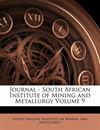Contact sorption drying of chromite concentrates
IF 0.9
4区 材料科学
Q4 METALLURGY & METALLURGICAL ENGINEERING
Journal of the Southern African Institute of Mining and Metallurgy
Pub Date : 2023-11-15
DOI:10.17159/2411-9717/2299/2023
引用次数: 0
Abstract
Due to the ultrafine particle size required for effective processing of chromite ores, dewatering of the concentrates presents a challenge. It is not uncommon for the ore to have elevated moisture contents even after dewatering, which must be reduced to required levels of between 8% and 10% by mass for further processing. Contact sorption drying has shown promise in test work on fine coal. This method was used to study the dewatering of chromite on a laboratory scale using 3 mm spherical activated alumina ceramic beads as a sorbent. Three different sorbent-to-chromite mass ratios, namely 0.5:1, 1:1, and 2:1, were tested with different process conditions, including dewatering in a stationary and a rotatingl bed. The experimental work showed that it was possible to achieve the target moistures in less than 10 minutes, irrespective of the sorbent-to-chromite ratio used. Ratios of 1:1 or higher, however, proved to be the best. The sorbent reusability at mass ratios of 1:1 and 2:1 were therefore tested. With a 1:1 mass ratio, the sorbents could be reused for three cycles, while with 2:1 ratio, the number of cycles increased to six. The sorbent-to-chromite mass ratio used had a significant influence on the required contact time and the reusability of the sorbents.铬矿精矿的接触吸附干燥
由于铬铁矿石的有效加工需要超细粒度,因此精矿脱水是一项挑战。即使在脱水后,矿石的含水量仍然很高,这种情况并不少见,必须将含水量降至所需的 8%至 10%(按质量计)的水平,才能进行进一步加工。接触吸附干燥法在精煤测试工作中显示出良好的前景。这种方法用于研究实验室规模的铬铁矿脱水,使用 3 毫米球形活性氧化铝陶瓷珠作为吸附剂。测试了三种不同的吸附剂与铬铁矿质量比,即 0.5:1、1:1 和 2:1,并采用了不同的工艺条件,包括在固定床和旋转床中脱水。实验结果表明,无论使用何种吸附剂与铬铁矿的比例,都可以在 10 分钟内达到目标湿度。不过,1:1 或更高的比例被证明是最好的。因此,我们测试了质量比为 1:1 和 2:1 的吸附剂的重复使用性。质量比为 1:1 时,吸附剂可重复使用三次,而质量比为 2:1 时,可重复使用的次数增加到六次。所使用的吸附剂与铬铁矿的质量比对所需的接触时间和吸附剂的可重复使用性有很大影响。
本文章由计算机程序翻译,如有差异,请以英文原文为准。
求助全文
约1分钟内获得全文
求助全文
来源期刊

Journal of the Southern African Institute of Mining and Metallurgy
METALLURGY & METALLURGICAL ENGINEERING-MINING & MINERAL PROCESSING
CiteScore
1.50
自引率
11.10%
发文量
0
审稿时长
4.3 months
期刊介绍:
The Journal serves as a medium for the publication of high quality scientific papers. This requires that the papers that are submitted for publication are properly and fairly refereed and edited. This process will maintain the high quality of the presentation of the paper and ensure that the technical content is in line with the accepted norms of scientific integrity.
 求助内容:
求助内容: 应助结果提醒方式:
应助结果提醒方式:


